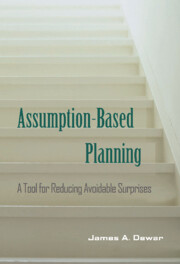If you are like me, whenever a new planning method or tool is described, you wonder how it relates to those planning methods or tools with which you are already familiar. Usually, the description of the method or tool does little to answer questions of this type. To find out how it relates to other methods or tools (and whether or not it is any good), you must wait, instead, for a review of the method by a planning maven.
A similar, but more awkward, situation occurs if you have been told to evaluate a new method and/or tool for its usefulness in your planning situation. If you cannot find a review of the method/tool, you must either wait for an expert review or you must make the comparisons yourself.
Partly because of the way in which Assumption-Based Planning (ABP) was developed, we have already done that work. ABP started out as the solution to a specific U.S. Army planning problem. When the Army asked us to reapply and document the “method” two years later, we searched through the literature to see how it related to other methods/tools.
Over the years, we have kept up that comparison effort, primarily as due diligence in understanding the literature and, secondarily, as a means of honing our own definitions. As anyone who has looked can attest, there is little standardization of terms and concepts in the large and varied literature on planning.
